Saturday, January 24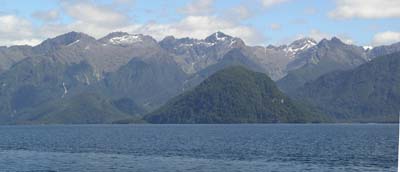
Paula: The morning was crisp and sunny as we enjoyed
another lovely (and large) English breakfast here in New Zealand. We have
delighted in the wonderful breakfasts here which always include eggs, bacon
or sausage, grilled mushrooms and tomatoes, as well as fresh fruit and toast.
The berries are always fresh and delicious. At breakfast, Jack shared with
us more about the history of the area and his homestead. He also described
how they maintain deer on their 6 acres to keep the foliage under control,
and almost on cue, the deer (including two fawns) arrived in the backyard.
Then, after a "wee bit" (New Zealand phrase) of schoolwork, we headed
for a small harbor to catch our ferry across Lake Manapouri en route to Doubtful
Sound.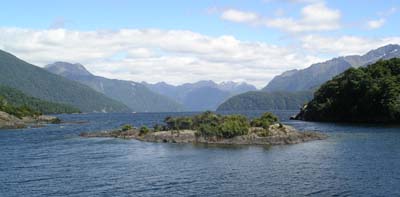
Lake Manapouri is one of the largest and deepest (440 meters) in New Zealand
and has 33 islands. It took the ferry took almost an hour to cross this beautiful
body of water. We learned that the lake was literally saved in the 1970s when
over 250,000 people signed a petition which forced the government to alter
the plans to raise the level of the lake by 30 meters (to allow for construction
of an underground hydroelectric plant). This petition also marked the beginning
of a huge environmental movement in New Zealand which continues to be evident
today. 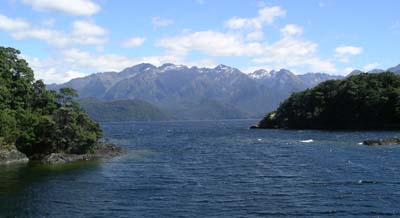
After crossing the lake, we boarded a bus to take us across the Wilmot Pass
where another boat was waiting for our cruise through the Doubtful Sound.
Before going through the pass, the bus stopped at the Manapouri Underground
Power Station. This is the largest hydroelectric power 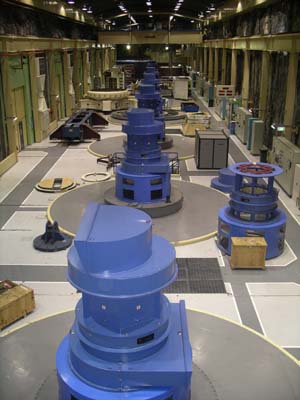 station
in New Zealand and provides 15% of the country's electricity. We drove 2 kilometers
down an underground tunnel to get to the station and then had an opportunity
to view the generators and machine hall. After learning about the small hydro-generator
at Lake Moeraki last week, it was interesting to see the same concepts applied
at this huge station.
station
in New Zealand and provides 15% of the country's electricity. We drove 2 kilometers
down an underground tunnel to get to the station and then had an opportunity
to view the generators and machine hall. After learning about the small hydro-generator
at Lake Moeraki last week, it was interesting to see the same concepts applied
at this huge station. 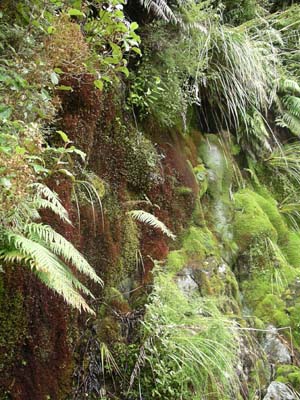
The 22 kilometer remote road through Wilmot's Pass is on gravel and narrow, and the scenery is beautiful. In addition to waterfalls, we stopped to observe the lush moss gardens growing on the rocky cliffs and marvel at the trees that have somehow managed to grow in the moss along the side of the cliffs. The top of the pass offered a spectacular outlook of the sound and we were fortunate to have a view - the pass is often shrouded in clouds. Interestingly, the pass was first discovered in the late 1800s by the Jack's (the proprietor of our guest house) great-grandfather.
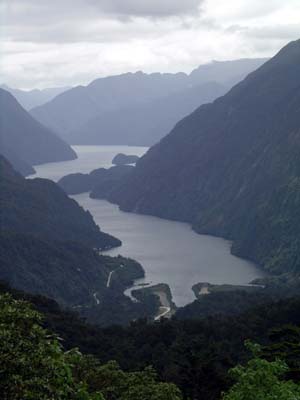 As
we drove over the pass, we were afforded a spectacular view of Doubtful Sound,
but we left behind our sunny day and entered the damp and cloudy climate of
the fiords. A fiord is an inlet from the ocean and there are fourteen along
New Zealand's west coast national park. Doubtful Sound (as it was named by
Captain Cook because he "doubted that if he sailed into the sound he
would be able to sail out") is the second largest sound and has many
islands and three long arms. It took us three hours to cruise the length of
the sound to the Tasman Sea and then back again.
As
we drove over the pass, we were afforded a spectacular view of Doubtful Sound,
but we left behind our sunny day and entered the damp and cloudy climate of
the fiords. A fiord is an inlet from the ocean and there are fourteen along
New Zealand's west coast national park. Doubtful Sound (as it was named by
Captain Cook because he "doubted that if he sailed into the sound he
would be able to sail out") is the second largest sound and has many
islands and three long arms. It took us three hours to cruise the length of
the sound to the Tasman Sea and then back again. 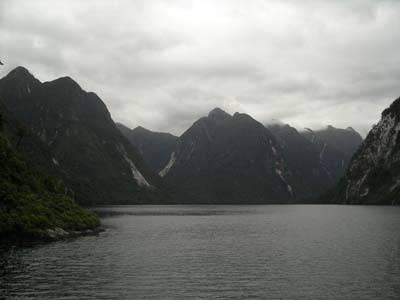 The
sound is striking, with huge cliffs on either side that shoot straight down
into the water. Waterfalls abound and so much fresh water runs into the sound
that the top 3 feet of the sound is actually fresh with salt water below.
These waterfalls only exist after rain, and disappear in the unusual case
where there's no precipitation for 2-3 days.
The
sound is striking, with huge cliffs on either side that shoot straight down
into the water. Waterfalls abound and so much fresh water runs into the sound
that the top 3 feet of the sound is actually fresh with salt water below.
These waterfalls only exist after rain, and disappear in the unusual case
where there's no precipitation for 2-3 days.
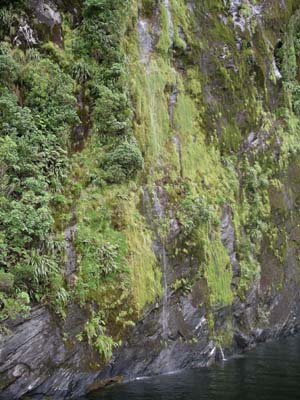 Several
times our boat cruised right along side the sides of the cliffs. The variety
and color of the moss and other vegetation is amazing. None of this land has
been disturbed by humans - it's exactly as it has appeared for thousands of
years. The trees that line the mountains are all growing in a thin layer of
moss, and have developed very strong root systems that spread widely. Many
of these trees are
Several
times our boat cruised right along side the sides of the cliffs. The variety
and color of the moss and other vegetation is amazing. None of this land has
been disturbed by humans - it's exactly as it has appeared for thousands of
years. The trees that line the mountains are all growing in a thin layer of
moss, and have developed very strong root systems that spread widely. Many
of these trees are  growing
on near-vertical cliffs, and during periods of unusually heavy rains (or snows),
it's not unusual for "tree avalanches" to occur. We also saw evidence
of the large earthquake (7.1 on the Richter Scale) that happened here in August
- there are several rock slides that are visible throughout the Sound.
growing
on near-vertical cliffs, and during periods of unusually heavy rains (or snows),
it's not unusual for "tree avalanches" to occur. We also saw evidence
of the large earthquake (7.1 on the Richter Scale) that happened here in August
- there are several rock slides that are visible throughout the Sound.
Today was cloudy and misty on Doubtful Sound, which is very typical of the weather here. We were fortunate to not have any rain, but the contrast between this side of the pass and Lake Manapouri is striking as there was bright and hot sun all day on the lake.
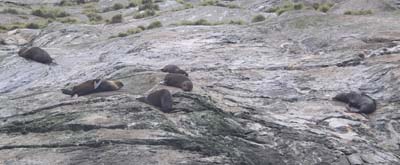 We
visited a colony of fur seals that live at the mouth of the sound - the females
and their pups all lounged on an outcrop of rocks. We had hoped to see dolphins
and penguins as well but they were not to be sighted. There were only a few
other boats in the sound and at one point the captain of our boat turned off
the motor so we could appreciate the peaceful tranquility the sound is know
for. The stillness was broken only by the sound of waterfalls and birds. We
found ourselves wishing that we could have explored the sound by sailboat
or kayak, enabling us to take in this tranquility for an entire day instead
of just moments.
We
visited a colony of fur seals that live at the mouth of the sound - the females
and their pups all lounged on an outcrop of rocks. We had hoped to see dolphins
and penguins as well but they were not to be sighted. There were only a few
other boats in the sound and at one point the captain of our boat turned off
the motor so we could appreciate the peaceful tranquility the sound is know
for. The stillness was broken only by the sound of waterfalls and birds. We
found ourselves wishing that we could have explored the sound by sailboat
or kayak, enabling us to take in this tranquility for an entire day instead
of just moments.
Tomorrow we'll drive east to the Otago Peninsula near Dunedin on the Pacific coast. We're looking forward to exploring this area's abundant wildlife, including albatross and penguins.
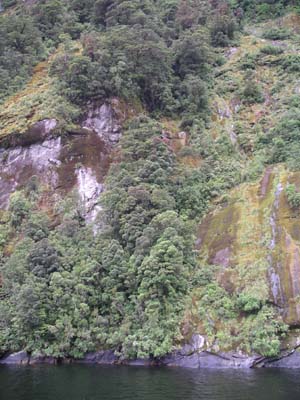
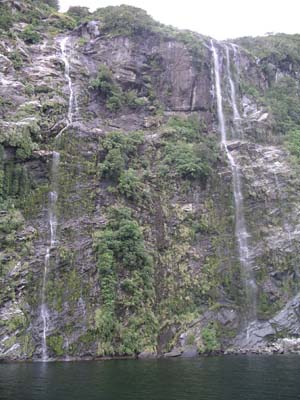
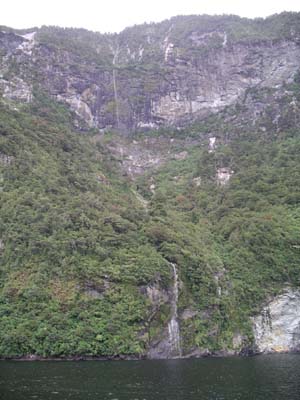
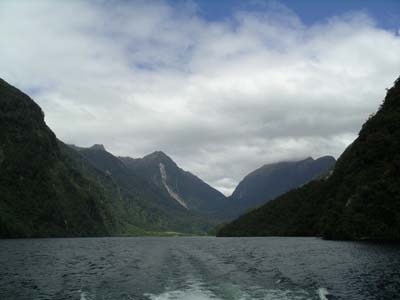
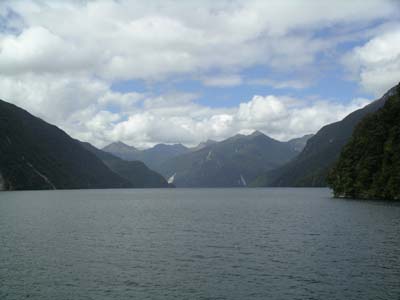
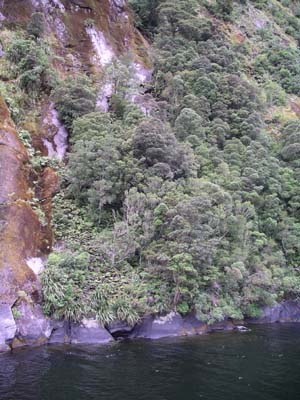
Katie's Kwick Kwacks - Moss and Trees Working Together. Today we saw a very interesting area of scenery. This area consisted of leaning trees planted in various types of moss along a mountain face. It was a very neat sight, but learning about it made it a lot more interesting. We learned that the area that all of these trees were growing was rock and didn't have any nutritious soil, so they had to root in moss instead. The moss was very cool looking - there were many different colors, varieties, and textures making a beautiful carpet over the entire mountain face. We learned that although the trees' roots will hold in this moss, they don't spread down very deep. All of their roots are intertwined and work together to basically just hold on. Life is very tough for these trees as the many natural disasters of New Zealand can destroy their thin root system. We enjoyed feeling all of the different mosses as well, and joked that they would make a good blanket for someone who got lost in the wilderness. All in all, this was a very interesting area to learn about and just another fascinating example of how New Zealand's plants adapt to their environment.
